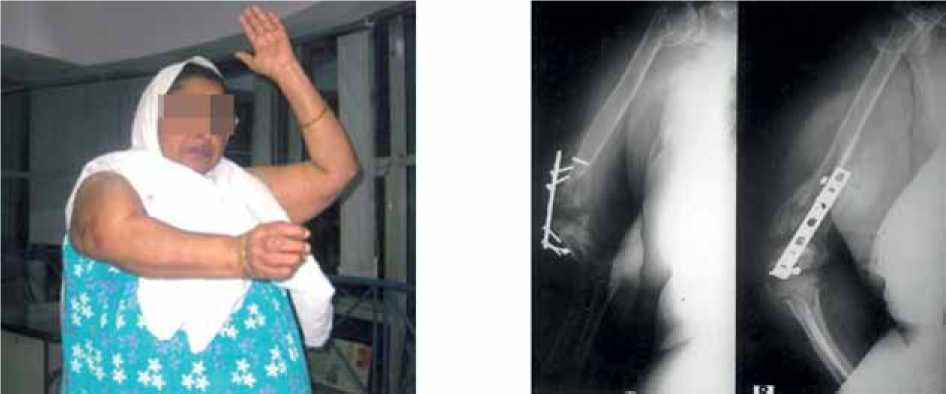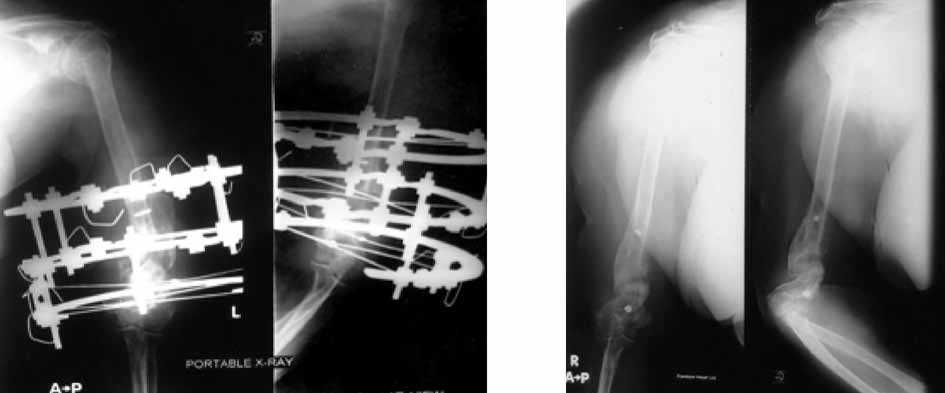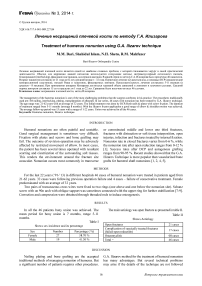Treatment of humerus nonunion using G.A. Ilizarov technique
Автор: Bari Mofakhkharul, Shahidul Islam, Shetu Nazmul Huda, Mahfuzer Rahman
Журнал: Гений ортопедии @geniy-ortopedii
Рубрика: Оригинальные статьи
Статья в выпуске: 3, 2014 года.
Бесплатный доступ
Treatment of humerus nonsense is one of the most difficult problems that a surgeon faces in his practical activity. Usually, the following methods are used to correct this pathology: intramedullary osteosynthesis with a nail, blocking (interlocking), fixing with plates, allotransplantation. In our series according to the GA method. Ilizarov treated 46 patients. The age of the patients ranged from 21 to 62 years, the average age was 32 years. Primary treatment was carried out using DCP (dynamic compression plate), Rush nails and plates fixed with screws. The duration of treatment was 5-11 months (on average 8 months). When using Ilizarov's apparatus, a good volume of movements in the elbow and shoulder joints was achieved. The average control period was 15 years from 1 year to 22 years. The striking was obtained in all 46 cases.
Humerus nonunion, ilizarov technique
Короткий адрес: https://sciup.org/142134595
IDR: 142134595
Текст научной статьи Treatment of humerus nonunion using G.A. Ilizarov technique
Humeral nonunions are often painful and unstable. Good surgical management is sometimes very difficult. Fixation with plates and screws and bone grafting may fail. The outcome of revision operation may be adversely affected by restricted movement of elbow. In most cases, the patient has been several times operated with resultant scarring and cicatrization of the surrounding soft tissues. This renders the environment around the fracture site avascular. Nonunion occurs most commonly in transverse
or comminuted middle and lower one third fractures, fractures with distraction or soft tissue interposition, open injuries, infection and fractures treated by internal fixation. Nonunion rate in closed fractures varies from 0-6 %, while the nonunion rate after open reduction ranges from 0-12 % [1]. Success rates after DCP and autogenous grafting ranges from 90-95 %. Recent studies showed that the G.A. Ilizarov Technique is more popular than vascularized bone grafts for humeral shaft nonunions [1, 2, 4, 5].
METHODS
For the last 22 years (’91-’13) in different hospitals 46 cases of humeral nonunion were treated in patients aged from 21-62 years. 32 cases were following previous operation failure and 4 cases – failure of conservative treatment. Female predominated with an average of 32 years.
Two pairs of transosseous cross wires were fixed to two rings (one above and one below the nonunion site). Schanz screw with on 90o arch with oblique support was sometimes connected with the upper ring for further stabilization [7-9]. Correction and compression were obtained through threaded rods to induce osteogenesis.
RESULTS
In all the 46 patients bony union was achieved. The mean period for bony union is 7 months, range 5-11 months.
Table I
The main aetiology was open fracture as presented in table II.
Table II
Shows sex incidence and its percentage
|
Sex |
Number |
Percentage ( %) |
|
Female |
27 |
58.70 % |
|
Male |
19 |
41.30 % |
Shows Aetiology
|
Open fractures |
21 cases |
|
Complication of surgically treated fractures (failed open reduction) |
17 cases |
|
Osteomyelitis |
08 cases |
|
Total = |
46 cases |
DISCUSSION
Nailing plating and bone grafting are the accepted traditional methods of managing nonunion of humerus. But a significant number of patients requires other procedures.
G.A. Ilizarov method for the treatment of humeral nonunion has many advantages. But several technical problems may arise if the details of the technique are not followed
precisely. For successful outcome it is important to maintain the bone ends in good and stable fixation. In order to provide firm stability and to avoid axial deviation during distraction, the assembly of fixator in our cases usually required one or two rings proximally, one or two distally. Another important factor is to achieve good contract of the bones. A partial contact in one of our cases was the cause of nonunion; but
in that case we refixed the apparatus and later on good union was achieved. Fixation with Ilizarov apparatus in the upper middle and lower third by using Schanz screw with 90o arch and oblique support is biomechanically and anatomically superior to that with a plate [1, 5, 6, 8, 10]. The most important thing is that the patient cane mobilize the shoulder and elbow soon after the operation with Ilizarov apparatus.
CONCLUSION
The Ilizarov technique for the treatment of humeral nonunion is very effective and offers many advantages. The advantages of this technique are that it allows for the simultaneous treatment
of infection, nonunion, shortening, deformity and problems of soft tissues. In all our cases complications were not severe and did not influence the results.

Fig. 2. Radiographic view. Implant failure of right humerus
Fig. 1. 67 years old lady. Deformity of right arm

-
Fig. 4. Full union is achieved
Fig. 3. Radiographic view of right humerus with the Ilizarov fixator in situ

-
Fig. 5. No deformity is visible (front view)


